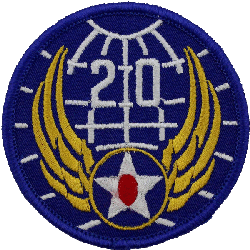The Twentieth Air Force was brought into existence on 4 April 1944 specifically to perform strategic bombardment missions against Japan.
This was done at the insistence of General Henry H. (Hap) Arnold, commander of the USAAF, mainly to avoid having the new B-29 Superfortress being diverted to tactical missions under pressure from the China Burma India Theater commanders. Twentieth Air Force was to be commanded by General Arnold himself at Joint Chiefs of Staff level. Twentieth Air Force was completely autonomous and its B-29s were to be completely independent of other command structures and would be dedicated exclusively against strategic targets in Japan.
In addition Twentieth Air Force was chosen (secretly) to be the operational component of the Manhattan Project in 1944, and performed the atomic attacks on Japan in August 1945. However, in early 1944, the B-29 was not yet operationally ready. The aircraft had been in development at Boeing since the late 1930s and the first XB-29 (41-0002) flew on 21 September 1942. However, the aircraft suffered from an overwhelming number of development issues, and with engine problems (fires). As a result, most of the first production B-29s were still held up at Air Technical Service Command modification centers, awaiting modifications and conversion to full combat readiness. By March 1944, the B-29 modification program had fallen into complete chaos, with absolutely no bombers being considered as combat ready. The program was seriously hampered by the need to work in the open air in inclement weather, as many hangars were simply too small to house the aircraft indoors; by delays in acquiring the necessary tools and support equipment, and by the USAAF's general lack of experience with the B-29.
General Arnold became alarmed at the situation and directed that his assistant, Major General B. E. Meyer, personally take charge of the entire modification program. The resulting burst of activity that took place between 10 March and 15 April 1944 came to be known as the "Battle of Kansas". Beginning in mid-March, technicians and specialists from the Boeing Wichita and Seattle factories were drafted into the modification centers to work around the clock to get the B-29s ready for combat. The mechanics often had to work outdoors in freezing weather. As a result of superhuman efforts on the part of all concerned, 150 B-29s had been handed over to the XX Bomber Command by 15 April 1944.
DEPLOYMENT
Advance Army Air Forces echelons arrived in India in December 1943 to organize the building of airfields in India and China. Thousands of Indians labored to construct four permanent bases in eastern India around Kharagpur. Meanwhile, 1,000 miles to the northeast, across the Himalayan mountains, about 350,000 Chinese workers toiled to build four staging bases in western China near Chengtu. By April 1944, eight B-29 airfields were available in Asia.
To avoid the risk that B-29s might be wasted by theater commanders on the battlefields when they would be much more useful against the Japanese home islands, the Joint Chiefs agreed in April 1944 to establish the Twentieth Air Force as a non-theater command controlled directly by the JCS, and approved Operation Matterhorn, a plan for bombing Japanese strategic targets with B–29s based in China. The B-29s would double as transports to carry their own fuel and cargo requirements over The Hump from India.[2] Acting as executive agent for the Joint Chiefs and with the approval of Roosevelt, Arnold named himself commander of the Twentieth Air Force. His Air Planner, Brig. Gen. Haywood S. Hansell served as its chief of staff and the remainder of the Air Staff at Headquarters AAF performed duplicate duties as the staff of the Twentieth. Centralized control of the Superfortresses from Washington marked the recognition of the B-29 as a strategic weapon that transcended theaters and services.
CHINA CAMPAIGN
That same month, the first Superfortresses arrived in India, having flown across the Atlantic Ocean, North Africa, Arabia, and Persia. Accompanying them was Major General Kenneth B. Wolfe, the new commander of the XX Bomber Command, which had been reassigned from the Second Air Force as the operational component of the Twentieth Air Force. The 58th Bombardment Wing headquarters also arrived in India during the spring of 1944. The 58th was the only wing to serve on the Asian mainland under the XX Bomber Command.
58th Bombardment Wing relocated to the Mariana Islands in late 1944, and continued the strategic bombardment campaign against Japan until the Japanese capitulation in August 1945.
Twentieth Air Force was attached to United States Strategic Air Forces in the Pacific, 16 July-6 December 1945.
The 20 AF's 509th Composite Group conducted the atomic attacks on Hiroshima and Nagasaki in August 1945, and remains as the only air force organization to have used a nuclear weapon in combat.
- General Henry 'Hap' Arnold, Apr 1943- Sep 45;
